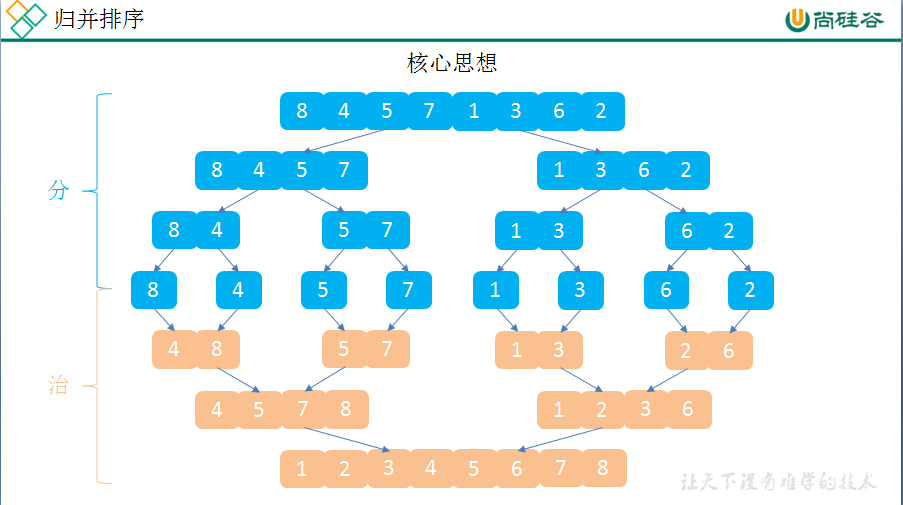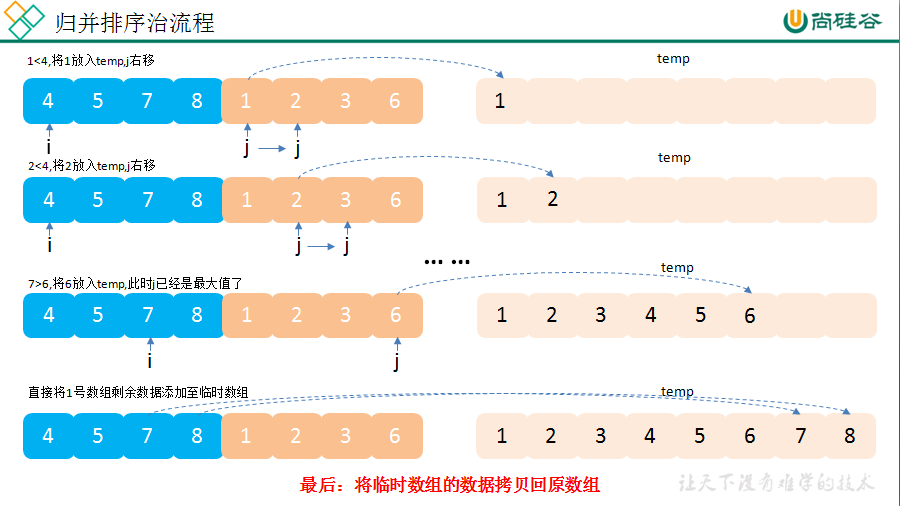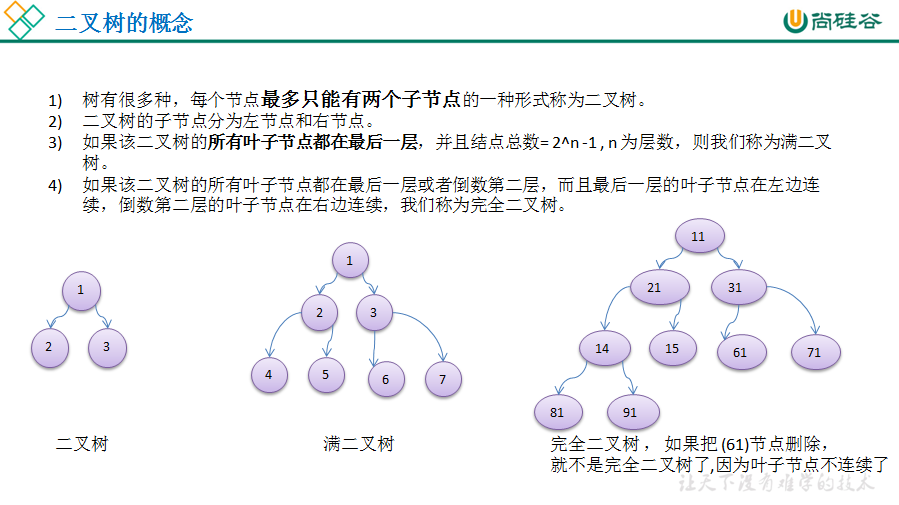6. 手写代码
6.1 基本算法
6.1.1 冒泡排序
/**
* 冒泡排序 时间复杂度 O(n^2) 空间复杂度O(1)
*/
public class BubbleSort {
public static void bubbleSort(int[] data) {
System.out.println("开始排序");
int arrayLength = data.length;
for (int i = 0; i < arrayLength - 1; i++) {
boolean flag = false;
for (int j = 0; j < arrayLength - 1 - i; j++) {
if(data[j] > data[j + 1]){
int temp = data[j + 1];
data[j + 1] = data[j];
data[j] = temp;
flag = true;
}
}
System.out.println(java.util.Arrays.toString(data));
if (!flag)
break;
}
}
public static void main(String[] args) {
int[] data = { 9, -16, 21, 23, -30, -49, 21, 30, 30 };
System.out.println("排序之前:\n" + java.util.Arrays.toString(data));
bubbleSort(data);
System.out.println("排序之后:\n" + java.util.Arrays.toString(data));
}
}
6.1.2 二分查找

图4-二分查找核心思路
实现代码:
/**
* 二分查找 时间复杂度O(log2n);空间复杂度O(1)
*/
def binarySearch(arr:Array[Int],left:Int,right:Int,findVal:Int): Int={
if(left>right){//递归退出条件,找不到,返回-1
-1
}
val midIndex = (left+right)/2
if (findVal < arr(midIndex)){//向左递归查找
binarySearch(arr,left,midIndex-1,findVal)
}else if(findVal > arr(midIndex)){//向右递归查找
binarySearch(arr,midIndex+1,right,findVal)
}else{//查找到,返回下标
midIndex
}
}
拓展需求:当一个有序数组中,有多个相同的数值时,如何将所有的数值都查找到。
代码实现如下:
/*
{1,8, 10, 89, 1000, 1000,1234} 当一个有序数组中,有多个相同的数值时,如何将所有的数值都查找到,比如这里的 1000.
//分析
1. 返回的结果是一个可变数组 ArrayBuffer
2. 在找到结果时,向左边扫描,向右边扫描 [条件]
3. 找到结果后,就加入到ArrayBuffer
*/
def binarySearch2(arr: Array[Int], l: Int, r: Int,
findVal: Int): ArrayBuffer[Int] = {
//找不到条件?
if (l > r) {
return ArrayBuffer()
}
val midIndex = (l + r) / 2
val midVal = arr(midIndex)
if (midVal > findVal) {
//向左进行递归查找
binarySearch2(arr, l, midIndex - 1, findVal)
} else if (midVal < findVal) { //向右进行递归查找
binarySearch2(arr, midIndex + 1, r, findVal)
} else {
println("midIndex=" + midIndex)
//定义一个可变数组
val resArr = ArrayBuffer[Int]()
//向左边扫描
var temp = midIndex - 1
breakable {
while (true) {
if (temp < 0 || arr(temp) != findVal) {
break()
}
if (arr(temp) == findVal) {
resArr.append(temp)
}
temp -= 1
}
}
//将中间这个索引加入
resArr.append(midIndex)
//向右边扫描
temp = midIndex + 1
breakable {
while (true) {
if (temp > arr.length - 1 || arr(temp) != findVal) {
break()
}
if (arr(temp) == findVal) {
resArr.append(temp)
}
temp += 1
}
}
return resArr
}
6.1.3 快排

图1-快速排序核心思想
代码实现:
/**
* 快排
* 时间复杂度:平均时间复杂度为O(nlogn)
* 空间复杂度:O(logn),因为递归栈空间的使用问题
*/
def quickSort(list: List[Int]): List[Int] = list match {
case Nil => Nil
case List() => List()
case head :: tail =>
val (left, right) = tail.partition(_ < head)
quickSort(left) ::: head :: quickSort(right)
}
6.1.4 归并

图2-归并排序核心思想
核心思想:不断的将大的数组分成两个小数组,直到不能拆分为止,即形成了单个值。此时使用合并的排序思想对已经有序的数组进行合并,合并为一个大的数据,不断重复此过程,直到最终所有数据合并到一个数组为止。

图3-归并排序“治”流程
代码实现:
/**
* 快排
* 时间复杂度:O(nlogn)
* 空间复杂度:O(n)
*/
def merge(left: List[Int], right: List[Int]): List[Int] = (left, right) match {
case (Nil, _) => right
case (_, Nil) => left
case (x :: xTail, y :: yTail) =>
if (x <= y) x :: merge(xTail, right)
else y :: merge(left, yTail)
}
6.1.5 二叉树之Scala实现
1)二叉树概念

2)二叉树的特点
(1)树执行查找、删除、插入的时间复杂度都是O(logN)
(2)遍历二叉树的方法包括前序、中序、后序
(3)非平衡树指的是根的左右两边的子节点的数量不一致
(4)在非空二叉树中,第i层的结点总数不超过 , i>=1;
(5)深度为h的二叉树最多有个结点(h>=1),最少有h个结点;
(6)对于任意一棵二叉树,如果其叶结点数为N0,而度数为2的结点总数为N2,则N0=N2+1;
3) 二叉树的Scala代码实现
定义节点以及前序、中序、后序遍历
class TreeNode(treeNo:Int){
val no = treeNo
var left:TreeNode = null
var right:TreeNode = null
//后序遍历
def postOrder():Unit={
//向左递归输出左子树
if(this.left != null){
this.left.postOrder
}
//向右递归输出右子树
if (this.right != null) {
this.right.postOrder
}
//输出当前节点值
printf("节点信息 no=%d \n",no)
}
//中序遍历
def infixOrder():Unit={
//向左递归输出左子树
if(this.left != null){
this.left.infixOrder()
}
//输出当前节点值
printf("节点信息 no=%d \n",no)
//向右递归输出右子树
if (this.right != null) {
this.right.infixOrder()
}
}
//前序遍历
def preOrder():Unit={
//输出当前节点值
printf("节点信息 no=%d \n",no)
//向左递归输出左子树
if(this.left != null){
this.left.postOrder()
}
//向右递归输出右子树
if (this.right != null) {
this.right.preOrder()
}
}
//后序遍历查找
def postOrderSearch(no:Int): TreeNode = {
//向左递归输出左子树
var resNode:TreeNode = null
if (this.left != null) {
resNode = this.left.postOrderSearch(no)
}
if (resNode != null) {
return resNode
}
if (this.right != null) {
resNode = this.right.postOrderSearch(no)
}
if (resNode != null) {
return resNode
}
println("ttt~~")
if (this.no == no) {
return this
}
resNode
}
//中序遍历查找
def infixOrderSearch(no:Int): TreeNode = {
var resNode : TreeNode = null
//先向左递归查找
if (this.left != null) {
resNode = this.left.infixOrderSearch(no)
}
if (resNode != null) {
return resNode
}
println("yyy~~")
if (no == this.no) {
return this
}
//向右递归查找
if (this.right != null) {
resNode = this.right.infixOrderSearch(no)
}
return resNode
}
//前序查找
def preOrderSearch(no:Int): TreeNode = {
if (no == this.no) {
return this
}
//向左递归查找
var resNode : TreeNode = null
if (this.left != null) {
resNode = this.left.preOrderSearch(no)
}
if (resNode != null){
return resNode
}
//向右边递归查找
if (this.right != null) {
resNode = this.right.preOrderSearch(no)
}
return resNode
}
//删除节点
//删除节点规则
//1如果删除的节点是叶子节点,则删除该节点
//2如果删除的节点是非叶子节点,则删除该子树
def delNode(no:Int): Unit = {
//首先比较当前节点的左子节点是否为要删除的节点
if (this.left != null && this.left.no == no) {
this.left = null
return
}
//比较当前节点的右子节点是否为要删除的节点
if (this.right != null && this.right.no == no) {
this.right = null
return
}
//向左递归删除
if (this.left != null) {
this.left.delNode(no)
}
//向右递归删除
if (this.right != null) {
this.right.delNode(no)
}
}
}
定义二叉树,前序、中序、后序遍历,前序、中序、后序查找,删除节点
class BinaryTree{
var root:TreeNode = null
//后序遍历
def postOrder(): Unit = {
if (root != null){
root.postOrder()
}else {
println("当前二叉树为空,不能遍历")
}
}
//中序遍历
def infixOrder(): Unit = {
if (root != null){
root.infixOrder()
}else {
println("当前二叉树为空,不能遍历")
}
}
//前序遍历
def preOrder(): Unit = {
if (root != null){
root.preOrder()
}else {
println("当前二叉树为空,不能遍历")
}
}
//后序遍历查找
def postOrderSearch(no:Int): TreeNode = {
if (root != null) {
root.postOrderSearch(no)
}else{
null
}
}
//中序遍历查找
def infixOrderSeacher(no:Int): TreeNode = {
if (root != null) {
return root.infixOrderSearch(no)
}else {
return null
}
}
//前序查找
def preOrderSearch(no:Int): TreeNode = {
if (root != null) {
return root.preOrderSearch(no)
}else{
//println("当前二叉树为空,不能查找")
return null
}
}
//删除节点
def delNode(no:Int): Unit = {
if (root != null) {
//先处理一下root是不是要删除的
if (root.no == no){
root = null
}else {
root.delNode(no)
}
}
}
6.2 开发代码
6.2.1 手写Spark-WordCount
val conf: SparkConf =
new SparkConf().setMaster("local[*]").setAppName("WordCount")
val sc = new SparkContext(conf)
sc.textFile("/input")
.flatMap(_.split(" "))
.map((_, 1))
.reduceByKey(_ + _)
.saveAsTextFile("/output")
sc.stop()
6.3 手写HQL
6.3.1 手写HQL 第1题
表结构:uid,subject_id,score
求:找出所有科目成绩都大于某一学科平均成绩的学生
数据集如下
1001 01 90 1001 02 90 1001 03 90 1002 01 85 1002 02 85 1002 03 70 1003 01 70 1003 02 70 1003 03 85
1)建表语句
create table score(
uid string,
subject_id string,
score int)
row format delimited fields terminated by '\t';
2)求出每个学科平均成绩
select
uid,
score,
avg(score) over(partition by subject_id) avg_score
from
score;t1
3)根据是否大于平均成绩记录flag,大于则记为0否则记为1
select
uid,
score,
avg(score) over(partition by subject_id) avg_score
from
score;t1
4)根据学生id进行分组统计flag的和,和为0则是所有学科都大于平均成绩
select
uid
from
t2
group by
uid
having
sum(flag)=0;
5)最终SQL
select
uid
from
(select
uid,
if(score>avg_score,0,1) flag
from
(select
uid,
score,
avg(score) over(partition by subject_id) avg_score
from
score)t1)t2
group by
uid
having
sum(flag)=0;
6.3.2 手写HQL 第2题
我们有如下的用户访问数据
| userId | visitDate | visitCount |
| u01 | 2017/1/21 | 5 |
| u02 | 2017/1/23 | 6 |
| u03 | 2017/1/22 | 8 |
| u04 | 2017/1/20 | 3 |
| u01 | 2017/1/23 | 6 |
| u01 | 2017/2/21 | 8 |
| U02 | 2017/1/23 | 6 |
| U01 | 2017/2/22 | 4 |
要求使用SQL统计出每个用户的累积访问次数,如下表所示:
| 用户id | 月份 | 小计 | 累积 |
| u01 | 2017-01 | 11 | 11 |
| u01 | 2017-02 | 12 | 23 |
| u02 | 2017-01 | 12 | 12 |
| u03 | 2017-01 | 8 | 8 |
| u04 | 2017-01 | 3 | 3 |
数据集
u01 2017/1/21 5 u02 2017/1/23 6 u03 2017/1/22 8 u04 2017/1/20 3 u01 2017/1/23 6 u01 2017/2/21 8 u02 2017/1/23 6 u01 2017/2/22 4
1)创建表
create table action (userId string, visitDate string, visitCount int) row format delimited fields terminated by "\t";
2)修改数据格式
select
userId,
date_format(regexp_replace(visitDate,'/','-'),'yyyy-MM') mn,
visitCount
from
action;t1
3)计算每人单月访问量
select
userId,
mn,
sum(visitCount) mn_count
from
t1
group by
userId,mn;t2
4)按月累计访问量
select
userId,
mn,
mn_count,
sum(mn_count) over(partition by userId order by mn)
from t2;
5)最终SQL
select
userId,
mn,
mn_count,
sum(mn_count) over(partition by userId order by mn)
from
( select
userId,
mn,
sum(visitCount) mn_count
from
(select
userId,
date_format(regexp_replace(visitDate,'/','-'),'yyyy-MM') mn,
visitCount
from
action)t1
group by userId,mn)t2;
6.3.3 手写HQL 第3题
有50W个京东店铺,每个顾客访客访问任何一个店铺的任何一个商品时都会产生一条访问日志,访问日志存储的表名为Visit,访客的用户id为user_id,被访问的店铺名称为shop,请统计:
1)每个店铺的UV(访客数)
2)每个店铺访问次数top3的访客信息。输出店铺名称、访客id、访问次数
数据集
u1 a u2 b u1 b u1 a u3 c u4 b u1 a u2 c u5 b u4 b u6 c u2 c u1 b u2 a u2 a u3 a u5 a u5 a u5 a
1)建表
create table visit(user_id string,shop string) row format delimited fields terminated by '\t';
2)每个店铺的UV(访客数)
select shop,count(distinct user_id) from visit group by shop;
3)每个店铺访问次数top3的访客信息。输出店铺名称、访客id、访问次数
(1)查询每个店铺被每个用户访问次数
select shop,user_id,count(*) ct from visit group by shop,user_id;t1
(2)计算每个店铺被用户访问次数排名
select shop,user_id,ct,rank() over(partition by shop order by ct) rk from t1;t2
(3)取每个店铺排名前3的
select shop,user_id,ct from t2 where rk<=3;
(4)最终SQL
select shop, user_id, ct from (select shop, user_id, ct, rank() over(partition by shop order by ct) rk from (select shop, user_id, count(*) ct from visit group by shop, user_id)t1 )t2 where rk<=3;
6.3.4 手写HQL 第4题
已知一个表STG.ORDER,有如下字段:Date,Order_id,User_id,amount。请给出sql进行统计:数据样例:2017-01-01,10029028,1000003251,33.57。
1)给出 2017年每个月的订单数、用户数、总成交金额。
2)给出2017年11月的新客数(指在11月才有第一笔订单)
建表
create table order_tab(dt string,order_id string,user_id string,amount decimal(10,2)) row format delimited fields terminated by '\t';
1)给出 2017年每个月的订单数、用户数、总成交金额。
select date_format(dt,'yyyy-MM'), count(order_id), count(distinct user_id), sum(amount) from order_tab where date_format(dt,'yyyy')='2017' group by date_format(dt,'yyyy-MM');
2)给出2017年11月的新客数(指在11月才有第一笔订单)
select count(user_id) from order_tab group by user_id having date_format(min(dt),'yyyy-MM')='2017-11';
6.3.5 手写HQL 第5题
有日志如下,请写出代码求得所有用户和活跃用户的总数及平均年龄。(活跃用户指连续两天都有访问记录的用户)日期 用户 年龄
数据集
2019-02-11,test_1,23 2019-02-11,test_2,19 2019-02-11,test_3,39 2019-02-11,test_1,23 2019-02-11,test_3,39 2019-02-11,test_1,23 2019-02-12,test_2,19 2019-02-13,test_1,23 2019-02-15,test_2,19 2019-02-16,test_2,19
1)建表
create table user_age(dt string,user_id string,age int)row format delimited fields terminated by ',';
2)按照日期以及用户分组,按照日期排序并给出排名
select dt, user_id, min(age) age, rank() over(partition by user_id order by dt) rk from user_age group by dt,user_id;t1
3)计算日期及排名的差值
select user_id, age, date_sub(dt,rk) flag from t1;t2
4)过滤出差值大于等于2的,即为连续两天活跃的用户
select user_id, min(age) age from t2 group by user_id,flag having count(*)>=2;t3
5)对数据进行去重处理(一个用户可以在两个不同的时间点连续登录),例如:a用户在1月10号1月11号以及1月20号和1月21号4天登录。
select user_id, min(age) age from t3 group by user_id;t4
6)计算活跃用户(两天连续有访问)的人数以及平均年龄
select count(*) ct, cast(sum(age)/count(*) as decimal(10,2)) from t4;
7)对全量数据集进行按照用户去重
select user_id, min(age) age from user_age group by user_id;t5
8)计算所有用户的数量以及平均年龄
select count(*) user_count, cast((sum(age)/count(*)) as decimal(10,1)) from t5;
9)将第5步以及第7步两个数据集进行union all操作
select
0 user_total_count,
0 user_total_avg_age,
count(*) twice_count,
cast(sum(age)/count(*) as decimal(10,2)) twice_count_avg_age
from
(
select
user_id,
min(age) age
from
(select
user_id,
min(age) age
from
(
select
user_id,
age,
date_sub(dt,rk) flag
from
(
select
dt,
user_id,
min(age) age,
rank() over(partition by user_id order by dt) rk
from
user_age
group by
dt,user_id
)t1
)t2
group by
user_id,flag
having
count(*)>=2)t3
group by
user_id
)t4
union all
select
count(*) user_total_count,
cast((sum(age)/count(*)) as decimal(10,1)),
0 twice_count,
0 twice_count_avg_age
from
(
select
user_id,
min(age) age
from
user_age
group by
user_id
)t5;t6
10)求和并拼接为最终SQL
select
sum(user_total_count),
sum(user_total_avg_age),
sum(twice_count),
sum(twice_count_avg_age)
from
(select
0 user_total_count,
0 user_total_avg_age,
count(*) twice_count,
cast(sum(age)/count(*) as decimal(10,2)) twice_count_avg_age
from
(
select
user_id,
min(age) age
from
(select
user_id,
min(age) age
from
(
select
user_id,
age,
date_sub(dt,rk) flag
from
(
select
dt,
user_id,
min(age) age,
rank() over(partition by user_id order by dt) rk
from
user_age
group by
dt,user_id
)t1
)t2
group by
user_id,flag
having
count(*)>=2)t3
group by
user_id
)t4
union all
select
count(*) user_total_count,
cast((sum(age)/count(*)) as decimal(10,1)),
0 twice_count,
0 twice_count_avg_age
from
(
select
user_id,
min(age) age
from
user_age
group by
user_id
)t5)t6;
6.3.6 手写HQL 第6题
请用sql写出所有用户中在今年10月份第一次购买商品的金额,表ordertable字段(购买用户:userid,金额:money,购买时间:paymenttime(格式:2017-10-01),订单id:orderid)
1)建表
create table ordertable(
userid string,
money int,
paymenttime string,
orderid string)
row format delimited fields terminated by '\t';
2)查询出
select userid, min(paymenttime) paymenttime from ordertable where date_format(paymenttime,'yyyy-MM')='2017-10' group by userid;t1 select t1.userid, t1.paymenttime, od.money from t1 join ordertable od on t1.userid=od.userid and t1.paymenttime=od.paymenttime; select t1.userid, t1.paymenttime, od.money from (select userid, min(paymenttime) paymenttime from ordertable where date_format(paymenttime,'yyyy-MM')='2017-10' group by userid)t1 join ordertable od on t1.userid=od.userid and t1.paymenttime=od.paymenttime;
6.3.7 手写HQL 第7题
有一个线上服务器访问日志格式如下(用sql答题)
时间 接口 ip地址
2016-11-09 11:22:05 /api/user/login 110.23.5.33
2016-11-09 11:23:10 /api/user/detail 57.3.2.16
.....
2016-11-09 23:59:40 /api/user/login 200.6.5.166
求11月9号下午14点(14-15点),访问api/user/login接口的top10的ip地址
数据集
2016-11-09 14:22:05 /api/user/login 110.23.5.33 2016-11-09 11:23:10 /api/user/detail 57.3.2.16 2016-11-09 14:59:40 /api/user/login 200.6.5.166 2016-11-09 14:22:05 /api/user/login 110.23.5.34 2016-11-09 14:22:05 /api/user/login 110.23.5.34 2016-11-09 14:22:05 /api/user/login 110.23.5.34 2016-11-09 11:23:10 /api/user/detail 57.3.2.16 2016-11-09 23:59:40 /api/user/login 200.6.5.166 2016-11-09 14:22:05 /api/user/login 110.23.5.34 2016-11-09 11:23:10 /api/user/detail 57.3.2.16 2016-11-09 23:59:40 /api/user/login 200.6.5.166 2016-11-09 14:22:05 /api/user/login 110.23.5.35 2016-11-09 14:23:10 /api/user/detail 57.3.2.16 2016-11-09 23:59:40 /api/user/login 200.6.5.166 2016-11-09 14:59:40 /api/user/login 200.6.5.166 2016-11-09 14:59:40 /api/user/login 200.6.5.166
1)建表
create table ip(
time string,
interface string,
ip string)
row format delimited fields terminated by '\t';
2)最终SQL
select
ip,
interface,
count(*) ct
from
ip
where
date_format(time,'yyyy-MM-dd HH')>='2016-11-09 14'
and
date_format(time,'yyyy-MM-dd HH')<='2016-11-09 15'
and
interface='/api/user/login'
group by
ip,interface
order by
ct desc
limit 2;t1
6.3.8 手写SQL 第8题
有一个账号表如下,请写出SQL语句,查询各自区组的money排名前十的账号(分组取前10)
1)建表(MySQL)
CREATE TABLE `account`
( `dist_id` int(11)DEFAULT NULL COMMENT '区组id',
`account` varchar(100)DEFAULT NULL COMMENT '账号',
`gold` int(11)DEFAULT 0 COMMENT '金币');
2)最终SQL
select
*
from
account as a
where
(select
count(distinct(a1.gold))
from
account as a1
where
a1.dist_id=a.dist_id
and
a1.gold>a.gold)<3;
6.3.9 手写HQL 第9题
1)有三张表分别为会员表(member)销售表(sale)退货表(regoods)
(1)会员表有字段memberid(会员id,主键)credits(积分);
(2)销售表有字段memberid(会员id,外键)购买金额(MNAccount);
(3)退货表中有字段memberid(会员id,外键)退货金额(RMNAccount)。
2)业务说明
(1)销售表中的销售记录可以是会员购买,也可以是非会员购买。(即销售表中的memberid可以为空);
(2)销售表中的一个会员可以有多条购买记录;
(3)退货表中的退货记录可以是会员,也可是非会员;
(4)一个会员可以有一条或多条退货记录。
查询需求:分组查出销售表中所有会员购买金额,同时分组查出退货表中所有会员的退货金额,把会员id相同的购买金额-退款金额得到的结果更新到表会员表中对应会员的积分字段(credits)
数据集
sale
1001 50.3
1002 56.5
1003 235
1001 23.6
1005 56.2
25.6
33.5
regoods
1001 20.1
1002 23.6
1001 10.1
23.5
10.2
1005 0.8
1)建表
create table member(memberid string,credits double) row format delimited fields terminated by '\t'; create table sale(memberid string,MNAccount double) row format delimited fields terminated by '\t'; create table regoods(memberid string,RMNAccount double) row format delimited fields terminated by '\t';
2)最终SQL
insert into table member
select
t1.memberid,
MNAccount-RMNAccount
from
(select
memberid,
sum(MNAccount) MNAccount
from
sale
where
memberid!=''
group by
memberid
)t1
join
(select
memberid,
sum(RMNAccount) RMNAccount
from
regoods
where
memberid!=''
group by
memberid
)t2
on
t1.memberid=t2.memberid;
6.3.10 手写HQL 第10题
1.用一条SQL语句查询出每门课都大于80分的学生姓名
name kecheng fenshu
张三 语文 81
张三 数学 75
李四 语文 76
李四 数学 90
王五 语文 81
王五 数学 100
王五 英语 90
A: select distinct name from table where name not in (select distinct name from table where fenshu<=80)
B:select name from table group by name having min(fenshu)>80
2. 学生表 如下:
自动编号 学号 姓名 课程编号 课程名称 分数
1 2005001 张三 0001 数学 69
2 2005002 李四 0001 数学 89
3 2005001 张三 0001 数学 69
删除除了自动编号不同, 其他都相同的学生冗余信息
A: delete tablename where 自动编号 not in(select min(自动编号) from tablename group by学号, 姓名, 课程编号, 课程名称, 分数)
3.一个叫team的表,里面只有一个字段name,一共有4条纪录,分别是a,b,c,d,对应四个球队,现在四个球队进行比赛,用一条sql语句显示所有可能的比赛组合.
答:select a.name, b.name
from team a, team b
where a.name < b.name
4.面试题:怎么把这样一个
year month amount
1991 1 1.1
1991 2 1.2
1991 3 1.3
1991 4 1.4
1992 1 2.1
1992 2 2.2
1992 3 2.3
1992 4 2.4
查成这样一个结果
year m1 m2 m3 m4
1991 1.1 1.2 1.3 1.4
1992 2.1 2.2 2.3 2.4
答案
select year,
(select amount from aaa m where month=1 and m.year=aaa.year) as m1,
(select amount from aaa m where month=2 and m.year=aaa.year) as m2,
(select amount from aaa m where month=3 and m.year=aaa.year) as m3,
(select amount from aaa m where month=4 and m.year=aaa.year) as m4
from aaa group by year
*********************************************************************5.说明:复制表(只复制结构,源表名:a新表名:b)
SQL: select * into b from a where 1<>1 (where1=1,拷贝表结构和数据内容)
ORACLE:create table b
As
Select * from a where 1=2
[<>(不等于)(SQL Server Compact)
比较两个表达式。 当使用此运算符比较非空表达式时,如果左操作数不等于右操作数,则结果为 TRUE。 否则,结果为 FALSE。]
6.
原表:
courseid coursename score
-------------------------------------
1 java 70
2 oracle 90
3 xml 40
4 jsp 30
5 servlet 80
-------------------------------------
为了便于阅读,查询此表后的结果显式如下(及格分数为60):
courseid coursename score mark
---------------------------------------------------
1 java 70 pass
2 oracle 90 pass
3 xml 40 fail
4 jsp 30 fail
5 servlet 80 pass
---------------------------------------------------
写出此查询语句
select courseid, coursename ,score ,if(score>=60, "pass","fail") as mark from course
7.表名:购物信息
购物人 商品名称 数量
A 甲 2
B 乙 4
C 丙 1
A 丁 2
B 丙 5
……
给出所有购入商品为两种或两种以上的购物人记录
答:select * from 购物信息 where 购物人 in (select 购物人 from 购物信息 group by 购物人 having count(*) >= 2);
8.
info 表
date result
2005-05-09 win
2005-05-09 lose
2005-05-09 lose
2005-05-09 lose
2005-05-10 win
2005-05-10 lose
2005-05-10 lose
如果要生成下列结果, 该如何写sql语句?
win lose
2005-05-09 2 2
2005-05-10 1 2
答案:
(1) select date, sum(case when result = "win" then 1 else 0 end) as "win", sum(case when result = "lose" then 1 else 0 end) as "lose" from info group by date;
(2) select a.date, a.result as win, b.result as lose
from
(select date, count(result) as result from info where result = "win" group by date) as a
join
(select date, count(result) as result from info where result = "lose" group by date) as b
on a.date = b.date;


